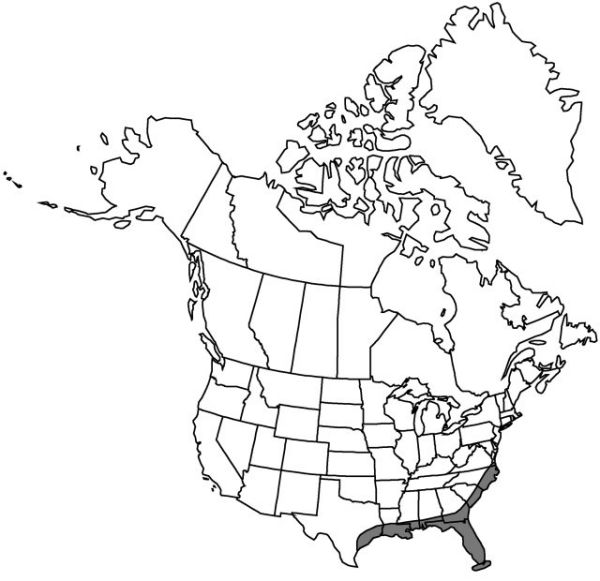Difference between revisions of "Yucca aloifolia"
Sp. Pl. 1: 319. 1753.
FNA>Volume Importer |
imported>Volume Importer |
||
| Line 8: | Line 8: | ||
}} | }} | ||
|common_names=Dagger plant | |common_names=Dagger plant | ||
| + | |special_status={{Treatment/ID/Special_status | ||
| + | |code=W2 | ||
| + | |label= | ||
| + | }} | ||
|basionyms= | |basionyms= | ||
|synonyms={{Treatment/ID/Synonym | |synonyms={{Treatment/ID/Synonym | ||
| Line 26: | Line 30: | ||
|phenology=Flowering fall. | |phenology=Flowering fall. | ||
|habitat=Sand dunes or shell mounds near coasts | |habitat=Sand dunes or shell mounds near coasts | ||
| − | |elevation= | + | |elevation=0–1800 m |
|distribution=Ala.;Fla.;Ga.;La.;Miss.;N.C.;S.C.;Tex.;Va.;Mexico;West Indies;Central America. | |distribution=Ala.;Fla.;Ga.;La.;Miss.;N.C.;S.C.;Tex.;Va.;Mexico;West Indies;Central America. | ||
|discussion=<p><i>Yucca aloifolia</i> has been widely cultivated, and horticultural forms (or varieties, depending upon the source) differ in the striping of yellow and white on the leaves. Results of DNA studies by K. H. Clary (1997) show a close relationship between this species and <i>Y. gloriosa</i>.</p> | |discussion=<p><i>Yucca aloifolia</i> has been widely cultivated, and horticultural forms (or varieties, depending upon the source) differ in the striping of yellow and white on the leaves. Results of DNA studies by K. H. Clary (1997) show a close relationship between this species and <i>Y. gloriosa</i>.</p> | ||
| Line 45: | Line 49: | ||
|phenology=Flowering fall. | |phenology=Flowering fall. | ||
|habitat=Sand dunes or shell mounds near coasts | |habitat=Sand dunes or shell mounds near coasts | ||
| − | |elevation= | + | |elevation=0–1800 m |
|distribution=Ala.;Fla.;Ga.;La.;Miss.;N.C.;S.C.;Tex.;Va.;Mexico;West Indies;Central America. | |distribution=Ala.;Fla.;Ga.;La.;Miss.;N.C.;S.C.;Tex.;Va.;Mexico;West Indies;Central America. | ||
|reference=None | |reference=None | ||
|publication title=Sp. Pl. | |publication title=Sp. Pl. | ||
|publication year=1753 | |publication year=1753 | ||
| − | |special status= | + | |special status=W2 |
| − | |source xml=https:// | + | |source xml=https://bibilujan@bitbucket.org/aafc-mbb/fna-data-curation.git/src/bb6b7e3a7de7d3b7888a1ad48c7fd8f5c722d8d6/coarse_grained_fna_xml/V26/V26_879.xml |
|genus=Yucca | |genus=Yucca | ||
|species=Yucca aloifolia | |species=Yucca aloifolia | ||
Revision as of 22:22, 27 May 2020
Plants forming colonies of rosettes, arborescent, to 7 m. Stems 1–3, erect or somewhat declining, simple or sparingly branched. Leaf blade erect, dark green, flattened or slightly concave, thick, 12–40 × 2.5–6 cm, rigid, margins sharply denticulate or entire, rarely filiferous with straight fibers. Inflorescences pendent, paniculate, arising 1/4–1/2 within rosettes, somewhat conical, 4.5–6.1 dm, glabrous or slightly pubescent; peduncle scapelike, to 3 dm. Flowers pendent, to 7 cm; perianth globose; tepals spreading, connate basally for less than 1 mm, creamy white tinged with green or purple near base, lanceolate, 3–4 × 1.2–2.2 cm; filaments ca. 2 cm; anthers 2–3 mm; pistil light green, 3–4 × 0.8–1 cm; ovary stipitate, 2–5 cm; style 5 mm; stigmas distinct. Fruits pendent, baccate, without core, indehiscent, 3.5–5 × 2–2.6 cm, with fleshy, succulent, purple pulp. Seeds dull black, round-ovate, 5–7 mm diam., 2.5 mm thick.
Phenology: Flowering fall.
Habitat: Sand dunes or shell mounds near coasts
Elevation: 0–1800 m
Distribution

Ala., Fla., Ga., La., Miss., N.C., S.C., Tex., Va., Mexico, West Indies, Central America.
Discussion
Yucca aloifolia has been widely cultivated, and horticultural forms (or varieties, depending upon the source) differ in the striping of yellow and white on the leaves. Results of DNA studies by K. H. Clary (1997) show a close relationship between this species and Y. gloriosa.
Selected References
None.